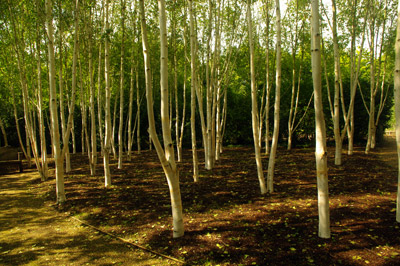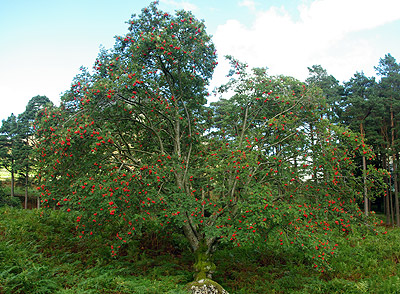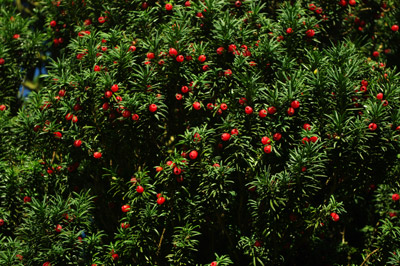Folk lore and tales about trees
Tree Lore
Apple
 If
the sun could be seen shining through the branches of an Apple
tree on December 25th - Christmas Day, then the owner of the
tree, if a farmer, would reap a healthy crop the following summer.
If the farmer wanted to ensure that this would happen he would
have put a piece of toast in the fork of the tree, or the largest
Apple tree in the orchard.
If
the sun could be seen shining through the branches of an Apple
tree on December 25th - Christmas Day, then the owner of the
tree, if a farmer, would reap a healthy crop the following summer.
If the farmer wanted to ensure that this would happen he would
have put a piece of toast in the fork of the tree, or the largest
Apple tree in the orchard.
Wassailing is a ceremony held in areas where cider was made, such as Somerset and the West Country of England. Celebrations focused on giving thanks to the wood spirits and all spirits that safeguarded the crop, culminating in songs and verses being chanted whilst the remaining cider was thrown over the trees.
Apple twigs make good divining rods (as good as any others that is).
The Celts believed that apples were the food of the gods.
Ash
 In
Dorset, the number of leaflets on an Ash leaf could be used
to predict the romantic future for girls.
In
Dorset, the number of leaflets on an Ash leaf could be used
to predict the romantic future for girls.
-
An even Ash leaf in my hand - The first I meet shall be
my man
The even Ash leaf in my bosom - The next I meet shall be my husband
Placing ash berries in a cradle prevents the child from being traded for a changeling.
It is an old belief that tools with handles made of ash enable more work to be done than by tools with handles made of other kinds of wood.
"Ash courts the flash." Ash trees were believed at attract lightning. Like the oak, they were used in European fire and rain-making ceremonies.
It was believed that so much hostility exists between adders and ash trees that if an adder is placed in a circle of ash leaves broken only by fire, it would go through the fire to escape.
Irish emigrants to America carried pieces of ash with them because its wood was a charm against drowning.
In England naked children were passed through cleft pollard ashes before sunrise as a cure for rupture.
A Yule log of ash is said to ensure the future prosperity of the family.
Aspen
 Aspen
is known as the "shivering tree" as the leaves are thought to
continuously tremble. There are many legends associated with
aspens and how they came to tremble.
Aspen
is known as the "shivering tree" as the leaves are thought to
continuously tremble. There are many legends associated with
aspens and how they came to tremble.
One is that Christ's cross was made from the wood of the Aspen tree, the tree was so filled with grief and remorse at being connected with the Crucifixion that it has trembled ever since.
A similar legend from Germany is that the Holy Family were walking in a forest and all the trees bowed reverently. The only tree that didn't was the Aspen, the Holy Child cursed the tree, and the leaves began to tremble and does so to this day.
Traditional Russian Proverb
-
'There is an accursed tree
which trembles without even a breath of wind.'
The Aspen has also been thought to help cure fevers. You need to take nail clippings from the sick person and place them in a hole cut in the trunk. The hole should then be covered again to seal the tree.

Beech
Amongst other light shiny barked trees the beech has always been a favourite of lovers shown by the many carvings of names or symbols on the bark, such carvings are called "arboroglyphs".
Carving the description of a wish onto a beech stick and then burying it will make the wish come true as the stick decays in the earth.
Travellers can safely shelter under a beech tree where no harm will befall them.
Diviners in search of water hidden underground are known to often use forked branches taken from the Beech tree traditionally called 'Wishing Rods'.
Water collected from hollows in old beech trees was thought to be a cure for skin complaints. Stuffing a mattress with beech leaves helps speed up the healing process.
Birch

Birch trees are the favourite trees of mythical creatures which inhabited Russian Forests known as "Forest Devils" or "Genii of the Forest". These beasts were said to view the world from the top of the trees. Able to transform their shape at will, the same height as trees when in the forest and as small as the smallest blade of grass when on open land. They may be made to appear by cutting Birch branches and placing them in a circle with the points towards the centre.
Placing a branch of the Birch tree above the front entrance to a property was thought to provide protection from any evil spirits and misfortune.
The bark of the Birch tree was traditionally used in ancient times for writing as it is extremely durable.
Cherry
 Repeat
this short rhyme when counting the number of Cherry stones you
have after a meal and you will know if and when you are to marry.
Repeat
this short rhyme when counting the number of Cherry stones you
have after a meal and you will know if and when you are to marry.
-
1. 'This year,
2. Next year,
3. Sometime,
4. Never.'...back to 1
The owner of a Cherry tree could be sure of having a rich crop of fruit if the first cherry to ripen was eaten by a woman who recently gave birth to her first child.
Elder
 It
was a British belief that placing a child in an elder-wood cradle
could cause it to be pinched black and blue by fairies. - (Serves
them right if you ask me, any-one who makes any kind of furniture
using light-weight, brittle, rot-prone elder wood needs something
to make them change their ways.)
It
was a British belief that placing a child in an elder-wood cradle
could cause it to be pinched black and blue by fairies. - (Serves
them right if you ask me, any-one who makes any kind of furniture
using light-weight, brittle, rot-prone elder wood needs something
to make them change their ways.)
Elder flowers were feared - Fen people though that if the
scent was inhaled for long, a deep coma and then death would
follow.
Branches of elder were buried with the dead to protect them
from evil spirits.
Elder-wood was used for the whip handles of hearse drivers.
The English believed that burning elder logs brought the
devil into the house.
The elder is associated with witches, who are said to sometimes
disguise themselves as elder trees.
It is said to be unlucky to break off an elder twig. One was supposed to ask permission of the elder tree or bush before pruning it, and to spit three times before cutting.
Hawthorn
 A
tree widely seen as one that brings good luck to the owner and
prosperity to the land where it stands.
A
tree widely seen as one that brings good luck to the owner and
prosperity to the land where it stands.
The 'Glastonbury Thorn' is a type of Hawthorn found in England (UK) and in some parts of Palestine. The tree is said to have been brought by Joseph Arimathea on a visit to England. Wherever Joseph traveled spreading the word of God, he carried a staff which he had acquired in Palestine. Legend tells that he visited the Isle of Avalon, Somerset (UK), which at one time was surrounded by water. Tired from traveling he sought rest and sat down upon "Weary-all Hill" now called "Worral Hill". Joseph stuck the staff into the ground, and legend says that it took root and a tree grew. A church was erected on the spot, now the site of 'Glastonbury Abbey'. The tree was seen as sacred and was reputed to only blossom on Christmas Day.
The flowers were highly prized and at one time exported around the world. It is believed that the Hawthorn had two trunks, but one was cut down. The perpetrator was revenged according to legend having one of his eyes taken out by the thorns in the process.
-
'He was well serv'd for his blind Zeale, who going to cut
doune an ancient white Hauthorne-tree, which, because she
budded before others, might be an occasion of Superstition,
had some of the prickles flew into his eye, and made him
Monocular.'
James Howell, 'Dodona's Grove' 1644
Cuttings are said to have been taken around Britain which still flower at Christmas. Although Hawthorn Trees can still be found in the abbey these are said to be cuttings of the tree as it believed to have been cut down during the English Civil War (the reign of King Charles II).
The flowering of the Hawthorn tree is a sure sign that winter is over and spring is underway, hence the tree has been viewed as an indicator of changes in the seasons or a weather omen. It is known simply as "May" in some parts of England as this is the month that it flowers where the blossoms are used to dress the May Queen on May Day and her consort the Green Man. "Ne'er cast a clout until May is out" refers to the blossom of the hawthorn rather than the month of May.
The Hawthorn in ancient mythology was created from lightning.
Germans traditionally used wood of the Hawthorn in funeral pyres as it was thought to assist the souls of the dead in ascension.
Hazel
 Hazel
can be used to decorate the hair with individual twigs or by
making a "Wishing Cap". This is custom followed in many countries.
If a person made a wish whilst wearing a wishing cap the wish
would be fulfilled.
Hazel
can be used to decorate the hair with individual twigs or by
making a "Wishing Cap". This is custom followed in many countries.
If a person made a wish whilst wearing a wishing cap the wish
would be fulfilled.
Hazel rods can be used for water divining and using a hazel stick to stir jam prevents it being stolen by fairies (the jam that is, not the stick even though it is now extra sticky).
The seeds of the hazel tree Hazel nuts, were also believed to possess mystical powers and could be used in divining. The nut is believed to be at its strongest on Halloween night, which was also called 'Nutcrack Night' in England. Lovers were recommended to use this to gain foresight into the relationship.
'Two hazel nuts I threw into the
flame,
And to each nut I gave a sweetheart's name.
This,
with the loudest bounce me sore amazed,
That, with a flame
of brightest colour blazed.
As blazed the nut, so may thy
passion grow,
For 'twas thy nut that did so brightly glow.'
Gray
Maple
 Passing
a young child through the branches of this tree has traditionally
thought to encourage good health and a long life for the child.
Passing
a young child through the branches of this tree has traditionally
thought to encourage good health and a long life for the child.
According to Alsatian folklore, placing branches of the Maple in a house or hanging around the doorway would ensure protection against bats who would then not dare enter. It would also ensure that any nesting storks were safe against disturbance or even the chicks being killed whilst still in their shells.
Maple wood is prized for magic wands used in spiritual healing.
A good wood for making pendulums from for the purpose of divination.
Maple wood is traditionally used to make masers/mazers from which are the ceremonial drinking bowls used during the wassailing of fruit orchards in mid January, the good health of the trees and the orchard are drunk using the bowl.
Oak
 Can
any other plant or tree have so many myths and legends surrounding
it? not to mention the very real part that this tree had
to play in England's role in world history. For hundreds of
years oaks provided the building material for her naval warships,
the source of England's "Heart of Oak".
Can
any other plant or tree have so many myths and legends surrounding
it? not to mention the very real part that this tree had
to play in England's role in world history. For hundreds of
years oaks provided the building material for her naval warships,
the source of England's "Heart of Oak".
Here are a few of the less weird ones.
Because of its deep roots the oak symbolizes a god whose
law extends to heaven, earth, and the underworld.
The oak is said to be sacred to: Allah - Jehovah - Zeus - Jupiter - Thor - Mars - the Dagda - Hercules - Hou, the oak god of Guernsey - Janicot, the Basque oak god - El, the Middle Eastern oak god - Jove - Picus - Cernunnos - Herne the Hunter - Taranis - Teutates - Belenos - Donar / Dunar / Thunar - Perkunas - Perun - Taraa - Baldur - Viribius - Janus. It is also the tree of the wild ox-god.
The image of Jupiter at the Capitol in Rome was originally an oak tree.
Mary was worshiped as Our Lady of the Oak in Anjou, France. She appeared to shepherd children in Portugal as Our Lady of Fatima, crowned in roses and hovering over an oak tree.
 The
oak is sacred to all thunder and lightning gods. Hercules attracted
thunderstorms with sympathetic magic, by rattling an oak club
in a hollow oak, or by stirring a pool with an oak branch. Clubs
were made of oak in ancient Europe. Woodpeckers were thought
to be knocking for rain when they tapped on oak trunks. Black
animals were sacrificed to the thunder god for rain. Oaks were
believed to court the lightning flash. Old English saying:
The
oak is sacred to all thunder and lightning gods. Hercules attracted
thunderstorms with sympathetic magic, by rattling an oak club
in a hollow oak, or by stirring a pool with an oak branch. Clubs
were made of oak in ancient Europe. Woodpeckers were thought
to be knocking for rain when they tapped on oak trunks. Black
animals were sacrificed to the thunder god for rain. Oaks were
believed to court the lightning flash. Old English saying:
-
Beware of an oak - It draws the stroke.
Rome awarded oak leaves to military heroes.
Primitive Europeans believed that oak fire strengthened the
sun. Sacrifices were made to sacred oaks in Europe until well
into the Middle Ages.
It was a crime to fell an oak tree in pagan Ireland. Kildare,
where the nuns of St. Brigit maintained the sacred fire, means
Shrine of the Oak.
In British folklore ancient, hollow trees (called bull oaks in England, bell oaks in Scotland and Ireland) are trees that stood in old sacred groves. They were often believed to be the home of spirits, elves, fairies or demons. You were supposed to turn your coat or cloak inside out to neutralize their magic:
-
Turn your cloaks - For fairy folks are in old oaks.
Their spirits were believed to enter houses through the knotholes
in oak timbers.
Druids stood their sacred circles of stones under the shadow
of a spreading oak or in a grove of oak trees. Pliny says that
the Druids believed that anything found growing on an oak tree
had been sent from heaven, a sign that the god had chosen the
tree and made it sacred. Mistletoe found on oaks was held especially
sacred. The Druids cut it each year with a golden sickle in
a ritual emasculation of the sacred oak, the royal sun disc.
Mistletoe does not usually grow on oaks, so it is likely that
they grafted it. They associated the oak with heavenly fire.
An oak tree had to be more than 30 years old before Druids would
harvest mistletoe from it.
Lithuanians offered sacrifices to oak trees for plentiful
crops.
Oak trees in Siberian groves were swathed in cloth and made offerings of kettles, reindeer hides, spoons and other valuable household articles. Orthodox Christians in Russia worshiped a holy oak until the 1870's. They fixed candles to its trunk and branches and prayed: "Holy oak hallelujah, pray for us. "
Acorns
Acorns were the Celtic symbol for Zeus, the Roman symbol of Jupiter. To Greeks and Romans the cupped acorn represented the penis glans (ooh err missus!)
Magic
Toothaches were cured in the 18th century by driving a nail
into the tooth or gum until it bled, then driving the nail into
an oak tree.
Rowan
 The
Welsh have traditionally considered the Rowan to be a sacred
tree. It is planted in churchyards to protect and act as a warning
to negative forces and evil spirits. Carrying pieces of the
tree protects against enchantment.
The
Welsh have traditionally considered the Rowan to be a sacred
tree. It is planted in churchyards to protect and act as a warning
to negative forces and evil spirits. Carrying pieces of the
tree protects against enchantment.
Coffins were rested under a Rowan tree on the way to the funeral rather than leave it open and vulnerable to approaches by such forces.
The mystic properties of the Rowan tree have been feared by witches.
-
An Ancient Song : 'Laidley Worm of Spindleton's Heuglis'
Their spells were vain, the boys returned
To
the Queen in sorrowful mood;
Crying that 'Witches have
no power
Where there is Rowan-tree wood.
Yew
 Since
ancient times the Yew has been viewed as a protector of the
dead.
Since
ancient times the Yew has been viewed as a protector of the
dead.
As an evergreen it represents everlasting life and the Yew
tree is widely planted in graveyards across Europe.
Some people even believed that the removal or cutting down
of the tree would result in misfortune and dire consequences.
Like the oak, the Yew has a particular part to play in the history of Great Britain as its wood was used to make longbows, used in particular by Welsh archers to end the supremacy of the knight in the middle ages and secure victories over the French such as at Agincourt.*
-
*Unfortunately Yew - at least English Yew, was never used
for making bows (also they were never called 'longbows',
that's a Victorian name, rather 'Great Bow' or 'War Bow').
English Yew is too full of knots, and they would break very
quickly. Ash, or Spanish Yew was preferred to make bows.
Peter Keen - Member of the Medieval Siege Society and Archer.
Copyright 2000 - present. All Rights Reserved | Privacy Policy Statement
